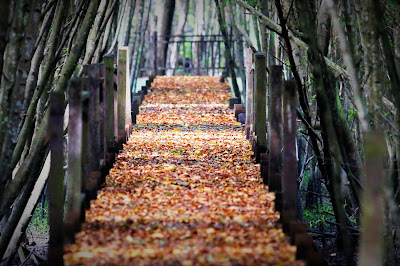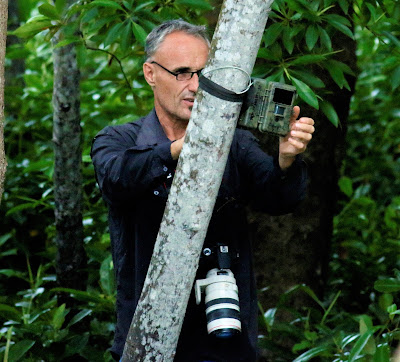Ever thought of having a tea reception here?
It felt like autumn but with a bit of humidity plus some mozzies and critters which may join you for the fun.
While exploring the mangrove area recently, i came across this "rare visitor" foraging deep inside the mangrove.
It felt like autumn but with a bit of humidity plus some mozzies and critters which may join you for the fun.
While exploring the mangrove area recently, i came across this "rare visitor" foraging deep inside the mangrove.
I didn't really get his name but i believe he is either a zoologist or perhaps a naturalist. While you are with a group of people, how would you know whether the person is a birder or not? Here are some pointers which you can look out for:
* He would try to name his son, "Albatross Lee" and his daughter "Niltava Smith".
* He would prefer to listen to the calls of Blyth's Pipit than the songs of Beatles.
* He would spent long hours looking at the photos of the birds rather than his wife's photos.
* He would decorate his house with things with bird motifs example mugs, wall paintings, clay figurines, etc
* He would insist that the pair of earrings with two doves is the nicest thing he has ever bought for his wife.
* He would named a corner of his house as the "stonechat corner" and would prefer to drive a car with some birds name imprinted on it, such as harrier or falcon.
* He would usually carry only a pair of bins and/or occasionally a field scope as well.
* He would be talking some terminology which sounded very alien to you eg 'carpal bars', 'scapulars', 'tarsus', 'median coverts', 'primary coverts', 'supercilium' etc etc.
....... bet you can come out with more !
I am happy to say that i have seen and photographed all the six (6) species of malkohas which can be found in Peninsular Malaysia
Holy crab ! This one looks like a disfigured crustacean.
One of the most common resident of the mangroves - the mudskippers (Periophthalmus gracilis)
Here are some common woody woodpeckers which can be found in the mangroves.
Common Flameback
If you have difficulties in differentiating between a Laced Woodpecker and a Streaked-Breasted Woodpecker, here are the photos of the two for comparison:
This Laced Woodpecker was seen in this mangrove area.
This Streaked-Breasted Woodpecker photo was taken at A.I.D swamp area recently.
* He would prefer to listen to the calls of Blyth's Pipit than the songs of Beatles.
* He would spent long hours looking at the photos of the birds rather than his wife's photos.
* He would decorate his house with things with bird motifs example mugs, wall paintings, clay figurines, etc
* He would insist that the pair of earrings with two doves is the nicest thing he has ever bought for his wife.
* He would named a corner of his house as the "stonechat corner" and would prefer to drive a car with some birds name imprinted on it, such as harrier or falcon.
* He would usually carry only a pair of bins and/or occasionally a field scope as well.
* He would be talking some terminology which sounded very alien to you eg 'carpal bars', 'scapulars', 'tarsus', 'median coverts', 'primary coverts', 'supercilium' etc etc.
....... bet you can come out with more !
The first bird which i have came across was this "Indian Cuckoo"
Based on B.i.W record, this was the only second reported sighting at this mangrove area while in E-Bird, this was the first recorded sighting at the moment. Apparently there are two subspecies of this cuckoo which are generally recognised (at the moment) in this region i.e i) C.m. micropterus and ii) C.m concretus. According to the Handbook of the Birds of the World Alive (HBW Alive), C.m. microterus is the winter visitor while C.m concretus is the resident bird which is reported to be much smaller and darker in color. Hard to tell whether the bird above is a winter visitor or a resident bird but i could only guess that it could be a winter visitor as its usual habitat is in the forest and not in the mangroves and to a certain extent due to its silent presence. However i could be wrong as R.K Sharma et. al (2015) in their study of the "Ecology and Evolution of Nest Parasitism in Indian Cuckoo" reported that the favourite host for the Indian Cuckoo are jungle babblers (T. affinis) while Sajeda Begum (2011) in her research reported that "Black Drongo" was the main host. Both the reported hosts however can't be found in this mangrove area while Abbot's Babbler (M. abbotti) and Javan Mynah are frequently seen here.
Beside Indian Cuckoo, Asian Koel or some books have called them "Black Cuckoo" (Eudynamys scolopacea) also practices brood parasitism or technically known as "klepto-parasitism" {cited R.K Sharma et al. (2015) }.
 |
| Asian Koel |
 |
| Chestnut-bellied Malkoha |
Holy crab ! This one looks like a disfigured crustacean.
One of the most common resident of the mangroves - the mudskippers (Periophthalmus gracilis)
There were no other waders around except for this lone Grey Heron.
Hiding inside the mangrove was this Crested Serpent Eagle. It tried to look elsewhere (buat dunno !) but i am sure it is aware of my presence. The traces of mud on its talons may have suggested that it could have preyed on some critters or fishes on the mud.
Here are some common woody woodpeckers which can be found in the mangroves.
Common Flameback
If you have difficulties in differentiating between a Laced Woodpecker and a Streaked-Breasted Woodpecker, here are the photos of the two for comparison:
 |
| Laced Woodpecker |
 |
| Streaked-Breasted Woodpecker |
From the above photos, the subtle difference which can be seen here is the color of their submoustachial stripe. The Laced Woodpecker has darker/more blackish stripe while the Streaked-Breasted Woodpecker's stripe is much brighter. Other feature which you can observe are their calls. Although their calls are alike which sounded like "trrrr", "trrrr", the calls made by a Streaked-Breasted Woodpecker are much louder than the ones made by a Laced Woodpecker (pers obs).
So there you go ! If your hubby or bf decided to take up bird watching as a hobby, do encourage him as it is a noble and interesting hobby. You can rest be ensured that they will certainly not able to find any foxey blondes or free flowing pubs in the jungle. The most they could find (besides the birds) are some crazy birders or a researcher like the above gentleman.
HAPPY BIRDING !













No comments:
Post a Comment